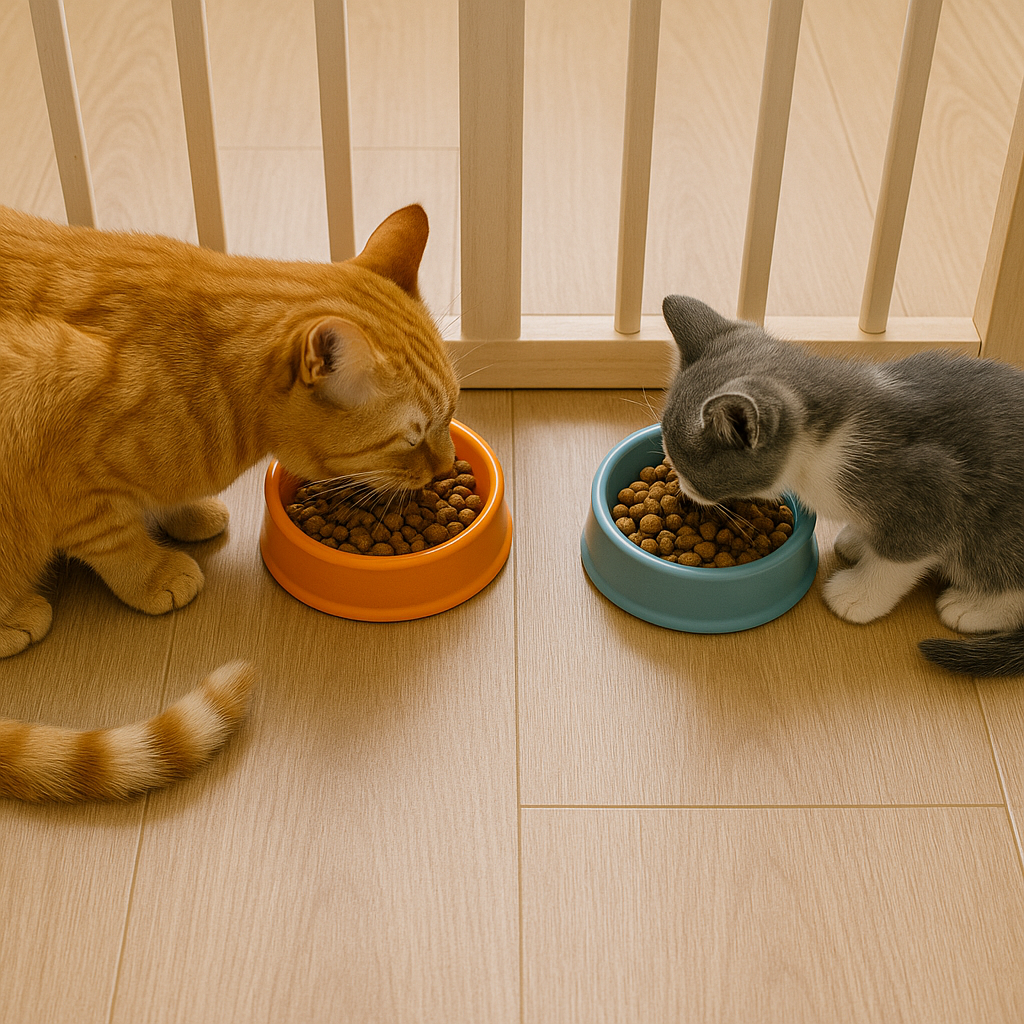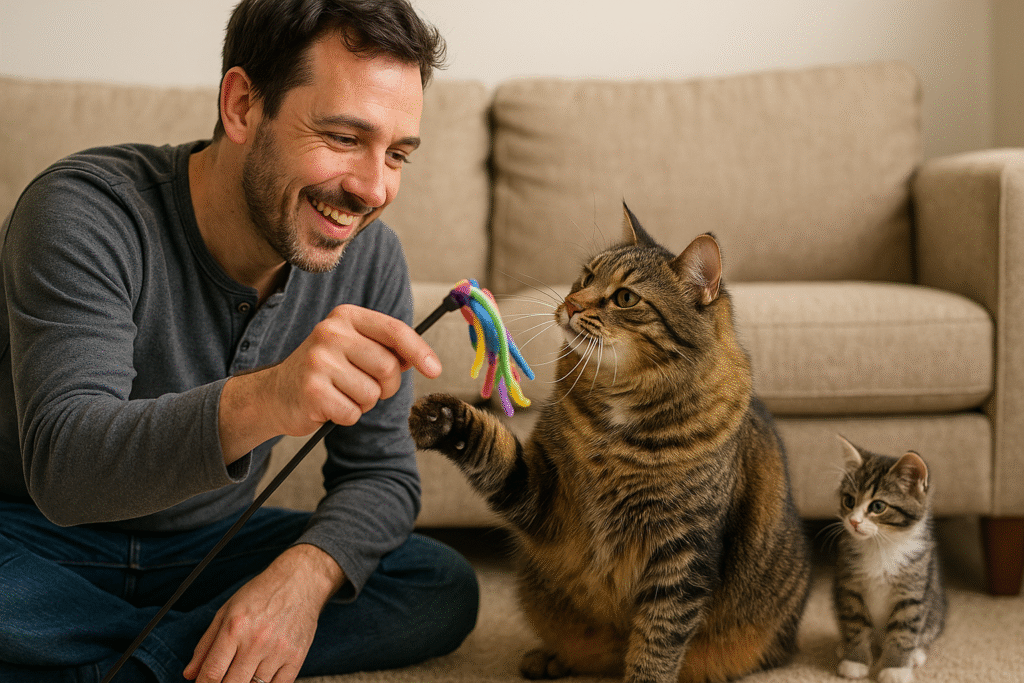Table of Contents
Key Takeaway
- Gradual introduction is crucial – Never rush the process; take 7-14 days at least
- Follow the 3-3-3 rule – 3 days for decompression, 3 weeks for adjustment, 3 months for full comfort
- Create separate spaces – Each cat needs their own territory initially
- Use scent swapping – Let cats smell each other before meeting face-to-face
- Feed them on opposite sides of a door – Positive associations with each other’s presence
- Supervise all interactions – Never leave them alone together until fully bonded
- Some hissing is normal – It’s part of establishing hierarchy, not necessarily aggression
You’ve fallen head over heels for that adorable kitten at the shelter. You’re wondering how your current feline overlord will react. I get it. The thought of disrupting your cat’s carefully curated kingdom can be nerve-wracking. But here’s the thing – with the right approach, you can transform potential enemies into lifelong companions.
Introducing a kitten to your cat isn’t just about throwing them together and hoping for the best. It’s an art form that requires patience, strategy, and a deep understanding of feline psychology. Think of yourself as a diplomatic mediator in the most important peace treaty your household has ever seen.

Why Proper Introduction Matters More Than You Think
Your resident cat has spent months (or years) perfecting their daily routine. They know exactly when breakfast happens. They know which sunny spot is theirs at 2 PM. They also know where the best hiding spots are. A new kitten? That’s like someone moving into your house uninvited and rearranging your furniture.
Cats are territorial creatures by nature. In the wild, establishing territory means survival. While your pampered house cat does not worry about their next meal, those instincts run deep. A poorly managed introduction can lead to stress, behavioral problems, and in some cases, permanent animosity between your cats.
The 3-3-3 Rule: Your Secret Weapon
Before we dive into the nitty-gritty, let me introduce you to the 3-3-3 rule – it’s like the golden standard of cat introductions:
- 3 days: Decompression period where both cats adjust to the new reality
- 3 weeks: Active adjustment phase where they learn to coexist
- 3 months: Full comfort and bonding development
This isn’t just some arbitrary timeline I pulled out of thin air. It’s based on feline behavioral science and has helped countless cat parents navigate this tricky transition.
Setting Up for Success: Pre-Introduction Preparation
Create Separate Kingdoms
Your new kitten needs their own space – think of it as a studio apartment within your home. This should include:
- A quiet room with a door (bathroom works great)
- Their own litter box, food, water, and toys
- Cozy hiding spots and vertical space
- Everything they need without venturing into your cat’s territory
Pro tip: Choose a room your current cat doesn’t frequent. Their favorite sunny bedroom corner? Not ideal.
Stock Up on Patience (And Treats)
I can’t stress this enough – this process takes time. Some cats become best friends in a week, others need several months. Your timeline depends on your cat’s personality, the kitten’s energy level, and how well you manage the introduction.

Step-by-Step Introduction Process
Phase 1: The Scent Introduction (Days 1-3)
Cats live in a world of scents. Before they even see each other, they should become familiar with each other’s smell.
Scent swapping technique:
- Pet your resident cat, then pet the kitten with the same hand
- Switch their bedding every few days
- Let them explore each other’s space while the other is secured elsewhere
- Feed them on opposite sides of the same door
During this phase, you might notice your cat acting differently. Some sniffing around the kitten’s room is normal. Excessive growling or signs of stress? Slow down the process.
Phase 2: The Visual Introduction (Days 4-7)
Time for the grand reveal. They’ll see each other but won’t have direct contact.
Baby gate method: Install a baby gate in the doorway of the kitten’s room. This allows visual contact while maintaining a safe barrier. Start with short sessions (5-10 minutes) and gradually increase based on their reactions.
Feeding time strategy: Place their food bowls on opposite sides of the gate. This creates positive associations – good things happen when the other cat is around.
Phase 3: Supervised Meetings (Days 8-14)
If both cats seem relaxed during visual contact, it’s time for carefully supervised face-to-face meetings.
The introduction protocol:
- Keep first meetings short (5-10 minutes)
- Stay calm and relaxed – cats pick up on your energy
- Have treats ready for positive reinforcement
- Let them approach each other naturally
- Don’t force interaction
Red flags to watch for:
- Prolonged staring (more than a few seconds)
- Puffed up fur or arched backs
- Aggressive vocalizations
- Swatting or lunging
If you see these signs, separate them right away and go back to the earlier phase.
Mastering the Art of Feeding Time
One of the most effective ways to build positive associations is through food. Cats are motivated by their stomachs, and mealtime can become a powerful bonding tool.
The Parallel Feeding Method
Place their food bowls on opposite sides of a closed door. Gradually move the bowls closer to the door over several days. This technique helps them associate each other’s presence with something positive.
Progressive timeline:
- Week 1: Bowls 6 feet from door
- Week 2: Bowls 3 feet from door
- Week 3: Bowls right next to door
- Week 4: Feeding with door cracked open
- Week 5: Feeding in same room under supervision

Understanding Normal vs. Worrying Behavior
What’s Normal During Introduction
Let’s be real – it’s not going to be sunshine and rainbows from day one. Some behaviors that worry you are actually completely normal:
Normal behaviors:
- First hissing and growling
- Hiding and avoiding each other
- Eating less for the first few days
- Changes in bathroom habits
- Increased vocalization
The hierarchy establishment: Your cats are essentially working out their social order. The older cat usually maintains “alpha” status, while the kitten learns the house rules. This process involves some posturing and boundary setting.
When to Be Concerned
While some tension is expected, certain behaviors signal you need to slow down or seek professional help:
Red flag behaviors:
- Persistent aggression beyond the first week
- Refusing to eat for more than 24 hours
- Eliminating outside the litter box after week two
- Excessive hiding or lethargy
- Injuries from fighting
The Gender Factor: Does It Really Matter?
Here’s something interesting I’ve learned over the years – gender combinations can influence how smoothly introductions go.
Generally easier combinations:
- Male cat + female kitten
- Two female (if properly introduced)
- Neutered males together
Trickier combinations:
- Two intact males
- Female cat + female kitten (territorial issues)
But remember, personality trumps gender every time. I’ve seen the most unlikely pairs become inseparable.
Creating Long-Term Harmony
Resource Management
Even after successful introduction, resource guarding can cause problems. Here’s how to prevent it:
Essential resources to multiply:
- Litter boxes (one per cat plus one extra)
- Food and water stations
- Scratching posts
- Cozy sleeping spots
- Toys and entertainment
The golden rule: If they have to compete for it, you need more of it.
Maintaining Individual Relationships
Don’t forget about your original cat during this process. They need extra attention and reassurance that they’re still loved and important.
Special bonding activities:
- Individual play sessions
- One-on-one cuddle time
- Maintaining their favorite routines
- Special treats just for them

Troubleshooting Common Problems
“My Cat Hates the Kitten After Two Weeks”
Don’t panic. Some cats need longer to adjust. Go back to earlier phases and slow down the process. Consider:
- Extending the separation period
- Using calming pheromones
- Consulting with a feline behaviorist
- Ensuring adequate resources for both cats
“The Kitten Won’t Stop Pestering My Older Cat”
Kittens have energy levels that can overwhelm adult cats. Solutions include:
- Separate play sessions to tire out the kitten
- Creating vertical escape routes for your older cat
- Establishing kitten-free zones
- Teaching boundaries through redirection
“They’re Fighting, Not Playing”
Learning to distinguish between play and aggression is crucial:
Play fighting characteristics:
- Silent or quiet vocalizations
- Relaxed body language
- Taking turns being “dominant”
- Brief pauses and grooming
Real fighting signs:
- Loud yowling and hissing
- Puffed up fur
- Ears flattened back
- Continuous aggression without breaks
When to Seek Professional Help
Sometimes, despite your best efforts, you need expert intervention. Consider consulting a feline behaviorist if:
- Aggressive behavior persists after one month
- Either cat shows signs of chronic stress
- You’re seeing regression in litter box habits
- Your own stress levels are affecting the process
The Long Game: Building Lasting Bonds
Remember, the goal isn’t necessarily to create best friends (though that’s a lovely bonus). Success means peaceful coexistence where both cats feel secure and comfortable in their shared space.
Signs of successful integration:
- Sleeping in the same room
- Grooming each other
- Playing together
- Sharing resources without tension
- Seeking each other out for companionship
Some cats become bonded within weeks, while others take months to fully accept each other. Both timelines are perfectly normal.
Final Thoughts: Patience Pays Off
Introducing a kitten to your cat is a life experience that tests your patience. Yet, it rewards you with years of feline entertainment. I’ve watched countless cats go from sworn enemies to grooming buddies, and it never gets old.
The key is respecting their individual personalities and timelines. Your anxious rescue cat might need a different approach than your confident social butterfly. Your kitten’s energy level and socialization history also play huge roles in the process.

Remember, every hiss and growl is part of their conversation. You’re not just introducing two cats. You’re facilitating a complex social negotiation. This process will decide their relationship for years to come.
Your next steps:
- Prepare your kitten’s separate space before bringing them home
- Commit to the gradual introduction process
- Stay patient and consistent with the timeline
- Celebrate small victories along the way
- Don’t hesitate to seek help if needed
The journey from strangers to companions is rarely linear. With patience, understanding, and the right approach, you’ll find yourself with a harmonious multi-cat household. It brings double the joy to your life.
Have you successfully introduced a kitten to your cat? Share your experience in the comments below. Your story will help another cat parent. They be navigating this exciting but challenging process.




